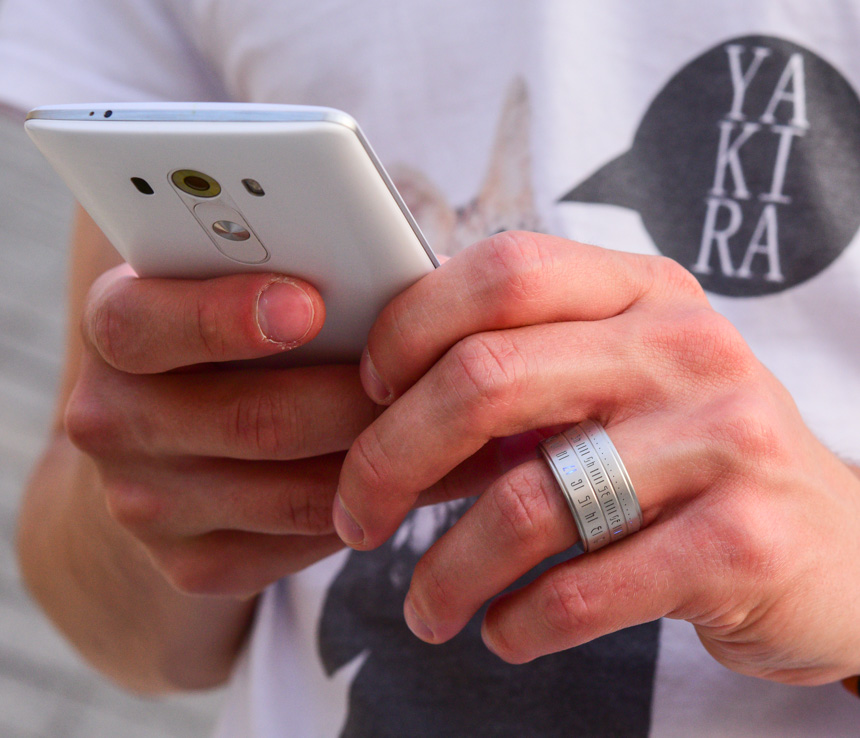
The category we use for our review posts is “Wrist Time Reviews.” That, for one, is because when we review something, we do not just go hands-on with it and call it a review, but spend actual time (at least a week, but generally quite a bit longer) wearing the timepiece on our wrist. Secondly, “wrist time” made sense for our wrist watch reviews – however, today we are looking at a very novel, dare I say, “futuristic” timepiece. Called the Ring Clock, this LED-based, battery-powered watch does what it says on the cover, and allows you to wear a piece of jewelry that tells the time. From concept to reality, let’s see how it fares in a review coming from a guy who’s never liked or worn any jewelry – admittedly apart from some diamond-set watches at trade shows when given the chance.
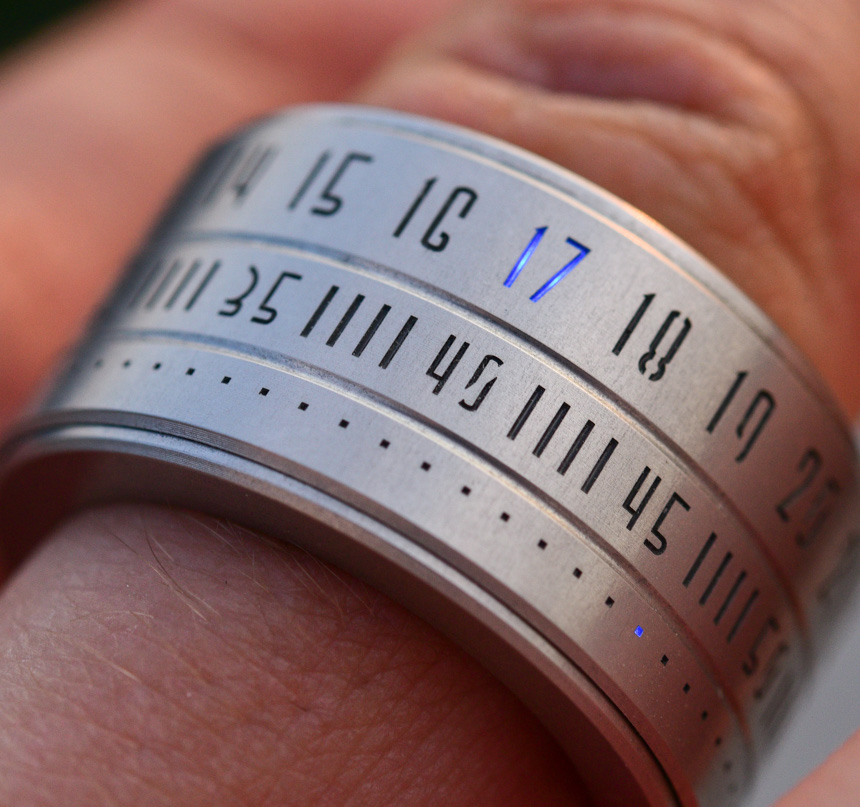
Prologue
First, some prologue and a quick look into the dreamworld of cool-looking new concepts. Day after day, all the core aBlogtoWatch team members receive numerous emails and “press alerts” (a term I hate with a passion), redirecting us to Kickstarter and Indiegogo campaigns designed to raise funds to finance what we’ll just call enthusiastic concepts. And while we’d love to bring all of these fascinating ideas to your attention, we simply cannot do that, for we want to show you only a curated selection of interesting and actually plausible projects.
So, with all these inquiries in mind, when I received an email – written in my mother tongue – from a fellow Hungarian, asking if we’d be interested in checking out their Ring Clock, I really didn’t know what to expect. I checked out their rather impressive computer-generated images, and after seeing what appeared to be a 22nd century device – a ring with tiny, unrealistically sharp, laser-etched numerals and ice cool blue lights – my first response to him was: “Sure, how close to completion is it?” To my surprise, he replied: “Oh, we’ve already made a few thousand.”
“…A few thousand?” Well, soon enough we set up a meeting, and I had a chance to have a first-hand experience with a working Ring Clock.

The Basics
The Ring Clock is – wait for it! – a ring, like pretty much any other, albeit it is a bit taller and a little bit thicker. It is composed of two key elements, an inner belt that is fixed in the sense that it does not rotate around your finger, and an external ring frame that carries all the numerals and spins around the internal, fixed belt. It indicates the time with LEDs and cut-out indices set on three tiers. The top being a 24-hour indicator, below it you find the minutes, and at the lowest level are the small squares for the seconds.
The external shell with all the numerals can be spun freely and easily, with little, nicely weighted resistance (the easiest way to achieve this when you wear the ring on your ring finger is to reach across with your thumb). The reason it spins is because that is how the LEDs are triggered – more on that a bit later.
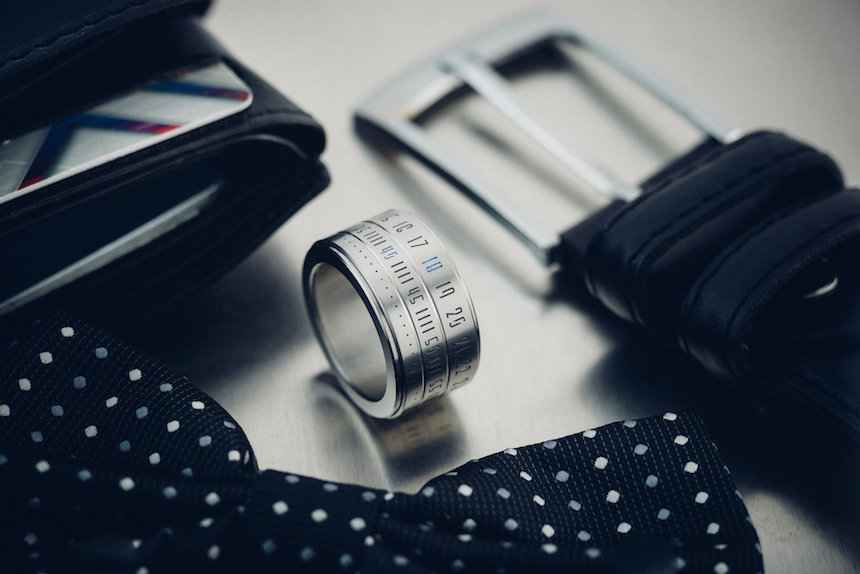
The Concept
The Ring Clock was designed by Gusztav Szikszai in 2011 for a challenge at CGSociety.org named Moving Innovation. The idea was to create visualization for a product that could not have existed then, but could exist 10 years on. Gusztav says: “I wanted to create something that is innovative, good to look at, and can actually be useful. I never wore a watch on my wrist because I don’t like the feeling, but I like watches in general, so I used that opportunity to let my mind come up with something that I could wear, the Ring Clock.” That is a clear and honest summary of the inspiration, and could also indicate a larger segment of future buyers of the product. Having a sleek idea is one thing; realizing it is where the real challenges lie – and where so many of these ideas die.
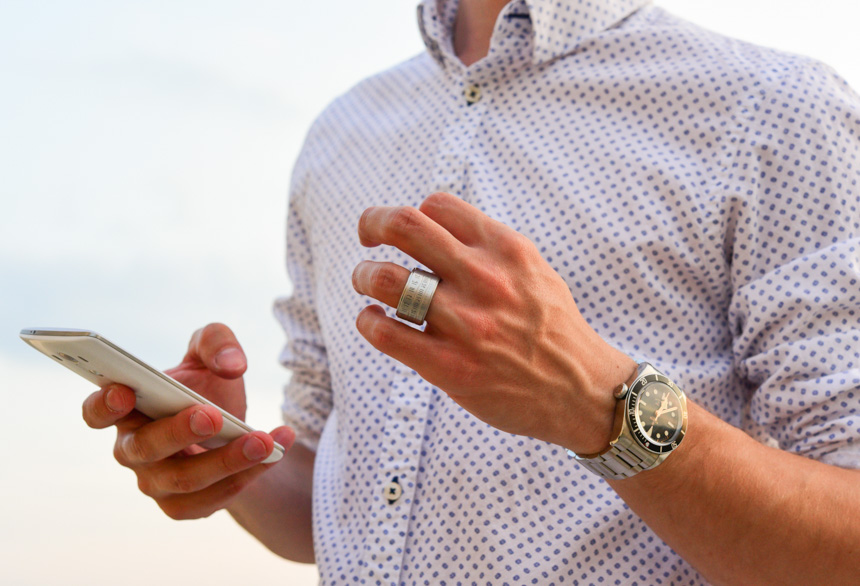
Banality alert: devices that do a lot for what they are and yet look simple and work in a user-friendly way are often novel and highly complex on the inside – this is one of the key factors that gained Apple its current status, for example… And the Ring Clock is another good one. It looks so simple, I could see how many couldn’t tell it was different to a normal ring in any way until they have inspected it more closely. However, the amount of time in research, engineering, and finding the best suppliers (and often modifying their delivered parts to suit the special spacial and functional requirements) that have gone into the Ring Clock is mind-boggling. Yet, the end result of all their efforts is a remarkably small, compact device that harnesses some of the most modern technologies – including one scarcely found even in the latest and greatest consumer electronics.

The Ring Clock is unique in the sense that it is a spec’d up version of a perfectly everyday item that has been around for literally ages. Having worn it for a couple of weeks – even at BaselWorld during a number of meetings – and shown it to watch industry insiders as well as friends and relatives not at all into watches and jewelry, I have seen two basic types of reactions. One, and there were rather few of these, were that of the unimpressed – but I guess they are just simply not as tech savvy as I and my fellow watch enthusiasts and nerds are. Second, and this is the group where I belonged when I first saw the Ring Clock, was that of a mix between awe, disbelief, and great fascination in how they got it to work. Interestingly, the most frequently heard first remark by far was how light it is compared to what they were expecting based on its looks. Second stage is discovering how it works.
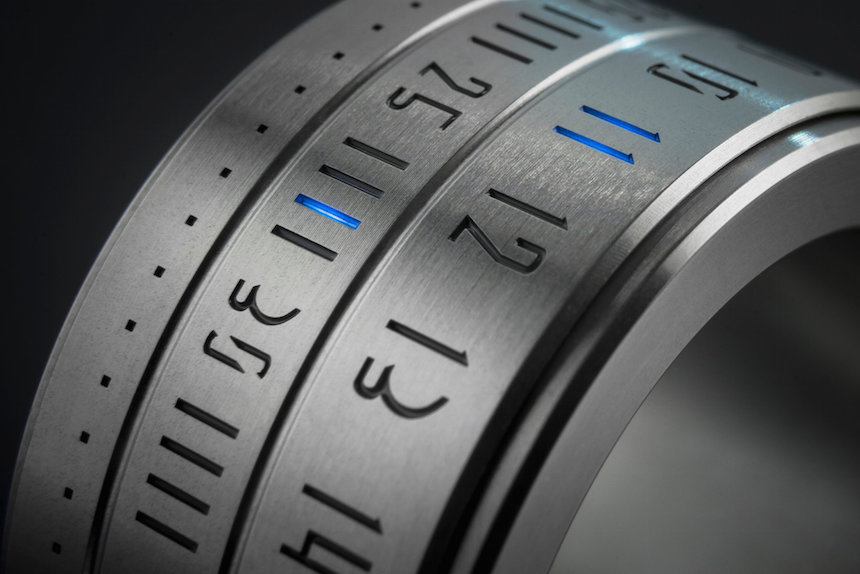
How Does It Work?
If you counted them all, you’d find that inside there are 168 LEDs – which are either colored ice blue or orange, depending on the version you get – connected to a specially and very cleverly modified printed circuitry. The funny thing is that basically all components inside the Ring Clock have been modified by the engineers here in Hungary: the circuitry and the way it has been coated and bent to the shape of the ring, the way the LEDs are connected to the single control unit, the way the battery is curved and charged, and so on.
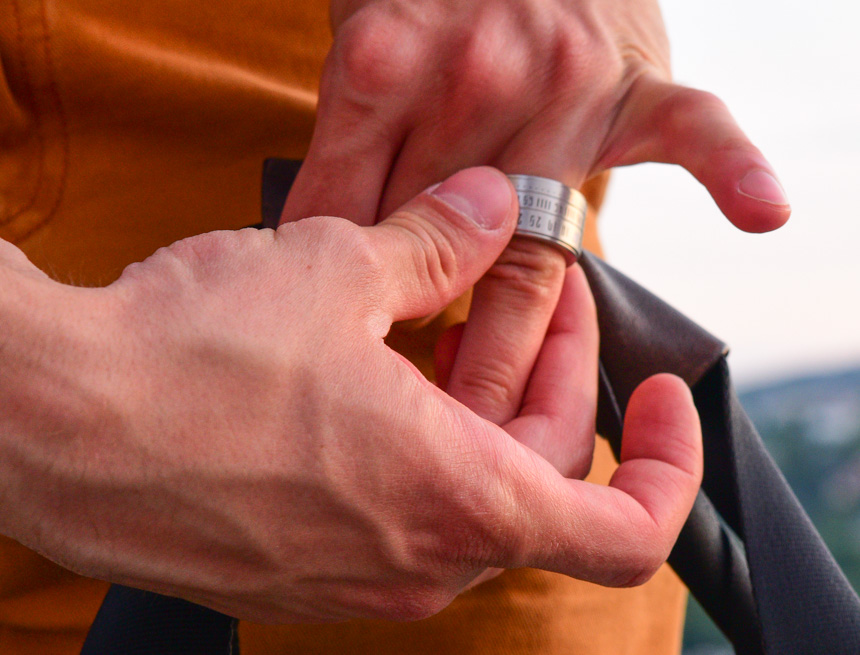
The lights are, of course, not always on. As I said, the outer frame has to be spun for the watch to indicate the time. It has two sensors installed, so the maximum rotation necessary for the LEDs to come on is one half – if the notch on the outer edge is closer to the sensor then it will take less. To be more energy efficient, the Ring Clock’s processor checks once every two seconds to see if the sensors have detected movement – so the absolute most you ever have to wait after rotating the ring is a bit less than 2 seconds. The LEDs then remain turned on for 15 seconds, or 5 when the battery is low on juice. The lights are bright and can be perfectly seen in even in a very well lit, bright room – outdoors under direct sunlight, you better cast a shadow over it with your other hand or else it will be difficult to find the lit numerals.
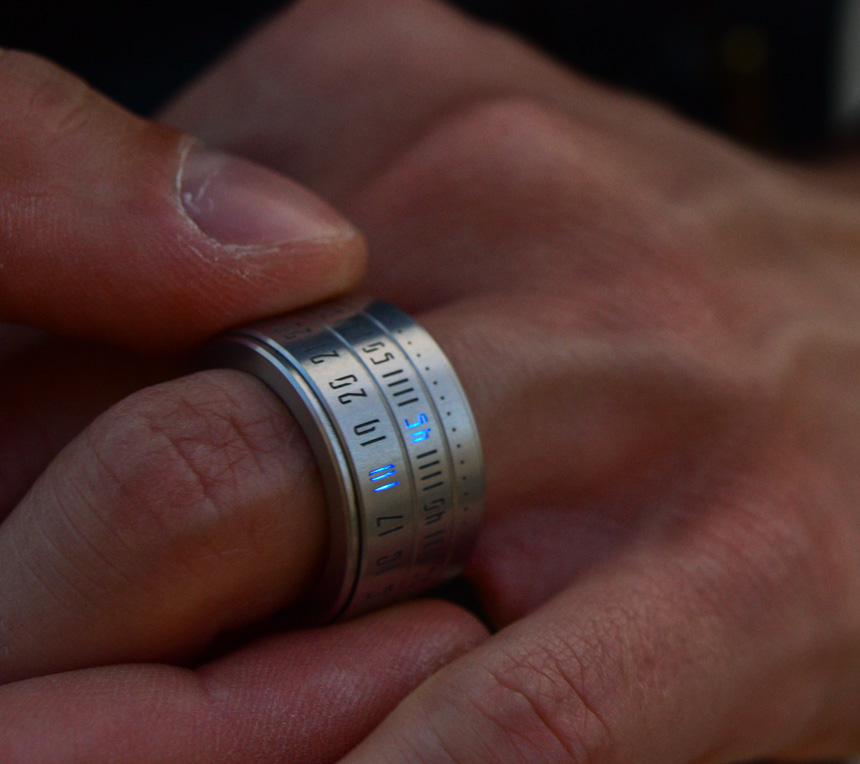
Other than under direct sunlight, though, it is amply bright, and indoors in a normal light or, especially in a more under-lit setting, the bright blue becomes immediately apparent and just looks downright stunning. Also, bear in mind the fact that no one can be used to seeing such a ubiquitous accessory, and especially one so small, to be glowing so bright. It is quite a spectacle when one makes hand gestures with the ring on and lit up.
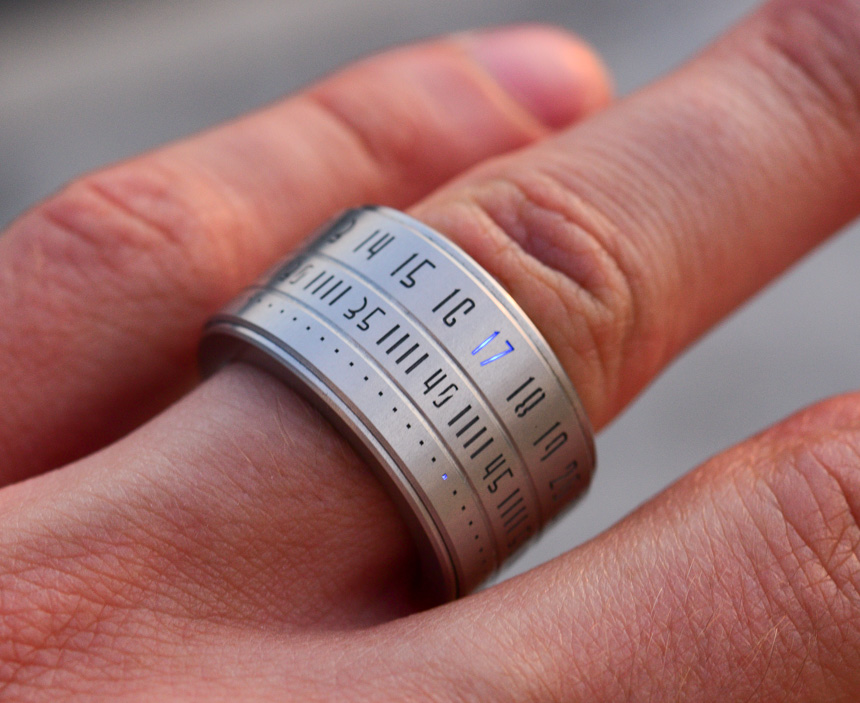
Reading the time can be tricky in the sense that the full periphery of the circle carries numerals, so sometimes rotating the ring in a way that shows you the actual time may be necessary. Fortunately, there is a setting where not only the actual minute marker, but all previous ones down to the last larger one divisible by 5 light up – this makes it considerably easier to find the minute indication. I have made a suggestion to the developers that, if possible, they may want to create a quick animation, where once the lights are required to come on, the LEDs would cycle from 12:00:01 to the actual time – this way one would just need to track the lights, making it easier to find the rough location where the activated indications are.
